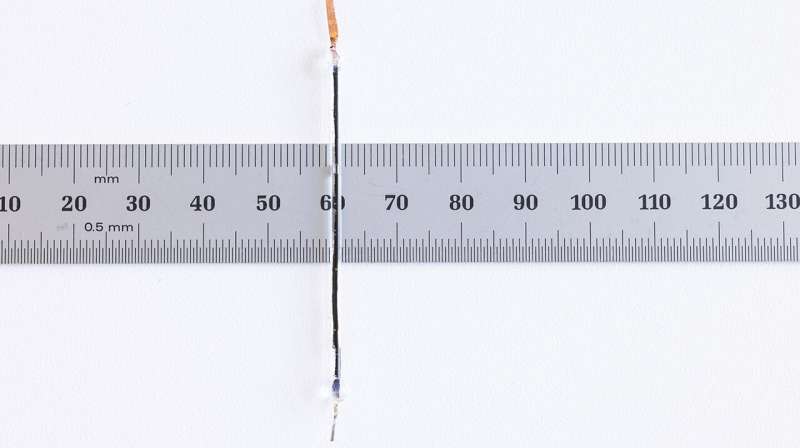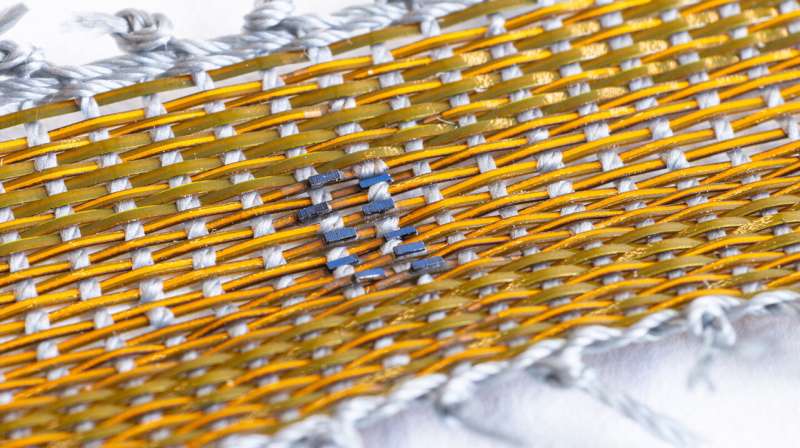Breakthrough process creates next generation of powered wearable fibers
Researchers from the Johns Hopkins Applied Physics Laboratory (APL) in Laurel, Maryland, have established new, scalable methods of developing battery- and solar-powered fibers, making it theoretically possible for electrical energy to be harvested from, and stored in, the clothing people wear.
These fibers could power high-performance wearable electronics that breathe, stretch and wash just like conventional textiles.
This development in fiber power sources—submillimeter-thin battery and photovoltaic strands that could be woven directly into fabrics—opens up a new world of wearable electronics and smart textiles.
Instead of carrying a heart monitor with bulky batteries, a patient could wear a shirt that has battery- and solar-powered fibers knit into it. Fiber-powered clothing could be heated to keep a person warm in cold environments, or laced with battery- and solar-powered fibers to provide soldiers with hands-free audio and video recording in the field.
“As demands for electronic textiles change, there is a need for smaller power sources that are reusable, durable and stretchable,” said Konstantinos Gerasopoulos, assistant program manager for physics, electronic materials and devices at APL and lead investigator of this project.
“Our vision is to develop solar harvesting fibers that can convert sunlight to electricity and battery fibers that can store the generated electricity in the textile.”
[embedded content]
Stretching the limits
Manufacturing and design have limited the scalability and performance of fiber batteries. Industrial textile equipment has been used to manufacture fiber batteries, but its massive scale limits its use to specialized facilities that are not compatible with the battery industry. Standard fiber batteries also suffer from lower performance because the electrodes are commonly twisted together, which renders most of the electrode surface inactive.
Now, in a study published in Advanced Materials Technologies, APL scientists have demonstrated a novel method to scale up fiber battery fabrication.
Rather than using textile equipment, the APL team customized battery equipment to achieve the thinness required for fiber batteries. This strategy, including the creation of customized roll-to-roll setups, made the process portable and suitable for large-scale production. All the equipment needed to create the fiber batteries could fit in a small room.
“We were always designing with roll-to-roll compatibility in mind,” said Rachel Altmaier, the paper’s lead author. “We need to be able to run all of our processes continuously or else what we develop isn’t relevant. This process could be dropped into an existing manufacturing line.”
The batteries are made of flat strips of anode and cathode electrodes and a polymer separator that are fed together into a heated roll press and laminated into a stacked design. The construction is similar to that of conventional pouch cells—think cell phone batteries—and provides stronger power and performance than standard fiber batteries. The stack is then laser-cut into a fiber-like strand roughly 700 micrometers wide—about the width of five human hairs.
This marks the first use of laser cutting on a full battery stack and demonstrates the method’s viability for customizing battery size and maintaining performance. The cutting system’s quickness also makes it scalable.

“We can process 100 meters of total fiber in a little over five hours,” said Jason Tiffany, an engineer at APL and co-author on the paper. “With our process, we can make the fibers smaller and more energy dense, which could open even more opportunities for textile applications.”
The fiber battery work adds to the team’s technology toolbox, which has included the development of a flexible lithium-ion battery that can operate under extreme conditions, as well as safe, fast-charging batteries.
In a second paper also published in Advanced Functional Materials, the APL team also addressed the challenge of making scalable, high-performing fibers that can harvest light and convert it into electricity.
“Just like with the battery fibers, we were inspired by conventional solar cell technology that is very efficient and robust,” said Gerasopoulos. “We asked, how can we turn these power sources into fibers?”
“The biggest challenge with current solar cell technology is its rigidity,” said Michael Jin, lead author of the solar cell paper. “You can imagine shrinking solar panels, like those on a rooftop, into a tiny solar fiber is very challenging.”
To overcome this challenge, the team leveraged a specific type of solar cell that has both positive and negative terminals on the back side in a finger-like pattern. Starting from this cell, the researchers cut and assembled tiny solar cells on thin, flexible circuit boards before sealing them in a protective polymer to create a fiber-like strand. The solar cells are so small they could fit between the ridges of a fingerprint.
“We used standard microelectronics fabrication processes to develop a novel approach that has transformed current rigid solar cell technology into flexible and durable fibers,” Jin said. “Even after bending the fiber 8,000 times, we saw no change in its performance.”
To further test the robustness of these fibers, the team continuously exposed them to light in the lab, simulating the total sunlight hours that Washington Dulles International Airport experiences in a typical spring month. Still, the fiber efficiency remained unchanged.
In a proof of concept, the researchers used a custom-built mini loom to weave nylon and solar cell fibers into a small textile. The swatch of fibers was placed under a lamp and attached to a small circuit board and an LED blinker, and within seconds, the strip powered the blinker’s flashing red light.
The method used to assemble and encapsulate the solar cells onto fiber substrates is also extensible to other sources. Instead of solar cells, it could be sensors, LEDs or batteries mounted onto the surface of flexible fibers, which could generate numerous functionalities.
“Our team continues to look for ways to create the most effective, resilient, cutting-edge power sources,” said Jeff Maranchi, research program area manager in APL’s Research and Exploratory Development Department.
“Textiles that integrate light energy harvesting and battery fibers could revolutionize what wearables today can achieve. Very soon, these fibers will enable distributed fabric-based power, heating, communications and sensing while providing the comfort and ease of regular textiles.”
More information:
Rachel A. Altmaier et al, High‐Linear‐Energy Layered Fiber Batteries Using Roll‐to‐Roll Lamination and Laser Cutting, Advanced Materials Technologies (2024). DOI: 10.1002/admt.202400417
Michael H.‐C. Jin et al, Scalable Crystalline Silicon Photovoltaic Fibers for Electronic Textile Applications, Advanced Functional Materials (2024). DOI: 10.1002/adfm.202402350
Johns Hopkins University
Citation:
Breakthrough process creates next generation of powered wearable fibers (2024, May 23)
retrieved 24 May 2024
from https://techxplore.com/news/2024-05-breakthrough-generation-powered-wearable-fibers.html
This document is subject to copyright. Apart from any fair dealing for the purpose of private study or research, no
part may be reproduced without the written permission. The content is provided for information purposes only.

Comments are closed